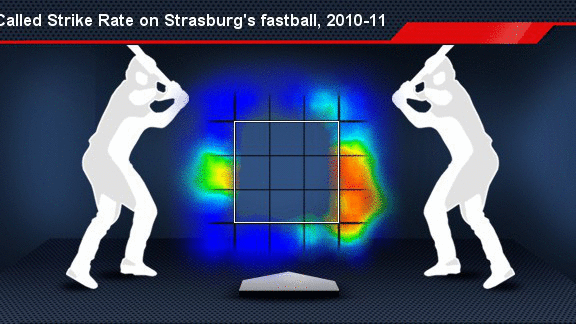Umps Not Buying Stephen Strasburg's Fastball
 Alec Dopp |
Alec Dopp |  Monday, January 13, 2014 at 10:42AM
Monday, January 13, 2014 at 10:42AM
Stephen Strasburg and the Washington Nationals avoided arbitration on Friday, agreeing to pay the now 25-year-old right-hander $3.975 million next year according to CBS Sports' Jon Heyman. In terms of value, 2013 was Strasburg's best season -- posting 3.1 wins above replacement after generating a 3.00 ERA and 1.05 WHIP over 30 starts. These were modest improvements from his 2012 campaign, where he posted a 3.16 ERA and 1.16 WHIP over 28 starts before being infamously shut down by his club in the heat of a pennant race. Strasburg was worth 3.0 wins that season, so it's not out of the question to assume he would've been worth more had his season not come to a decidedly screeching halt.
Yet for as impressive as Strasburg's statistics have been to this juncture of his career, one cannot overlook the regression of his strikeouts -- which have been arguably the most dominant aspect of his game. Last season, Strasburg punched out opponents in 26.1% of their plate appearances against him, enough for the seventh-best mark among qualified starters. Two seasons ago, that number was an astounding 30.2%, which was the best among starters who tossed at least 150 innings. Dialing back the time machine even further, Strasburg's strikeout rate from 2010 (his rookie season) to 2011 (the year he was shut down after five starts) stood at 32% -- the sixth-highest mark in baseball among all pitchers with 90 innings during that span.
Why have Strasburg's strikeouts decreased 5.9% since his entrance into the league four years (yes, it's been four years already) ago? Advanced scouting reports and exposure to his stuff may have at least something to do with it, and there's that whole Tommy John surgery thing that may certainly play a role. But more than anything else, I think it's the fact that umps aren't favoring his fastball quite as much.
Comparing called-strike rates on Strasburg's fastball since 2010
Strasburg's heater garnered a 13.7% called strike rate when located out of the zone over his 17 starts between 2010 to 2011. This was not a particularly lofty number, admittedly, as the league average mark was 12.2% over that span. But in 2012, that number decreased to 10% (lower than the 11.8% league average) and fell even further to 9.3% last season. Most of those called strikes have occured on the 'backdoor' portion of the plate to left-handed hitters or inside on righties, but as we see, that significantly decreased in frequency over the past two seasons.
What makes this decrease even more perplexing is that Strasburg's fastball velocity has decreased -- albeit minimally-- over the past three seasons, averaging 96.8 MPH in 2010-2011, 95.6 in 2012 and 95.3 in 2013. As my colleague David Golebiewski pointed out in his brillliant piece on Justin Verlander (if you haven't read it, you should), there tends to be an "inverse relationship between fastball velocity and called strike rate on out-of-zone fastballs -- the slower you throw, the more called strikes you get." Of course, this is more of a general statement and therefore isn't applicable in all cases, but we see that Strasburg is bucking the trend a bit in this respect, as his fastball velocity has decreased yet he is tabbing fewer out-of-zone called strikes.
What does it all mean?
Strasburg's progressive strikeout decrease has everything to do with him receiving fewer out-of-the-zone called strikes with his fastball. As the graph above shows, the fewer called strikes he receives with his heater, the less punchouts he is able to compile with it over time. Conversely, this has contributed to his increasing walk rate with the offering.
I've included a logarithmic projection for the first and second half of next season in the graph to get a sense for how (less) productive the pitch might be in the immediate future. Based off my findings, Strasburg fastball is on track to receive roughly an 8% out-of-zone called-strike rate by the end of next season, and could very well walk more batters (just over 10% in the projection) with the pitch than he strikes out (just under 10% according to the data). To put that into context? The league average starter's fastball generated a 15.9% strikeout rate and 8.4% walk rate last season.
Are umps not favoring Strasburg's fastball because it's lost some of the "flash" it showed during his 2010 campaign? We may never know. What I do know, however, is that this is concerning. A 25-year-old power arm once dubbed the best pitch prospect of his generation shouldn't see his strikeouts decreasing at this high of a rate.
 Stephen Strasburg,
Stephen Strasburg,  Washington Nationals
Washington Nationals


Reader Comments (2)
really interesting stuff ... could you becnhmark this against some other pitchers' starts to their careers as a follow-up? I'd like to understand how other hard throwers have fared in this regard as they broke into the league.
I did some research on the called strike zone during the PITCHf/x era, and found that between 2010-2013, the zone has changed noticeably. The zone is expanding down at the bottom, but pulling in at the sides, in particular on the outside corner to both LHH and RHH. (See THT Annual for details)
I think the "Out-of-Zone FB" grouping that you are looking at could be broken down by region to give you better results. I suspect you'd find most pitchers will have their heat maps on the sides of the plate that are called strikes get cooler during the same 2010-2013 period. If Strasburg is still pitching outside the edges and has not adjusted to the new zone, then he is going to see less out-of-zone strikes than he did when the "lefty strike" was still prominent in 2010.